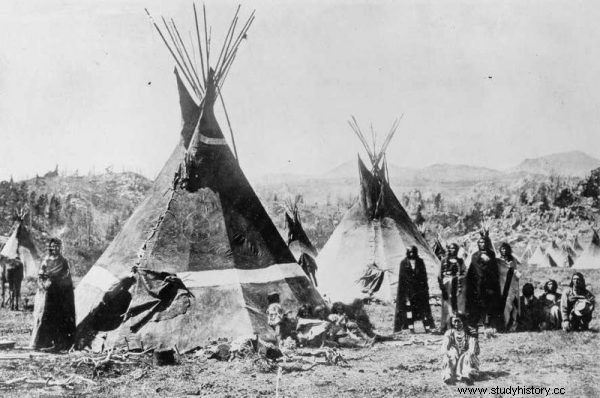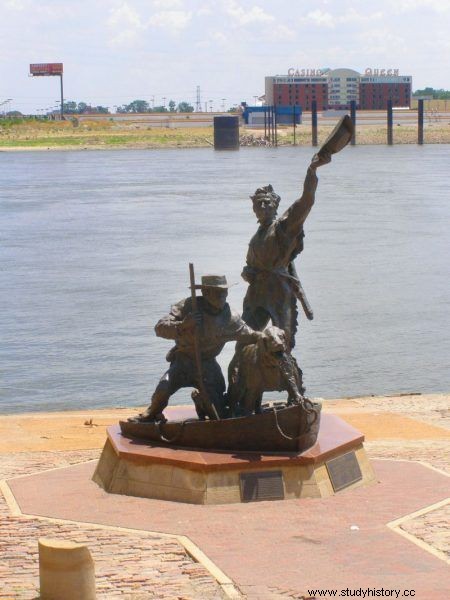It was said that they could conjure animals. It was believed that some ruled the forces of nature. They were considered to be trade and hunting specialists. They were born warriors. But not only. The world of Native American tribes is astonishing at various levels, according to discoverers working on special orders from President Jefferson.
The exploration of the Missouri River and its mainstream was the primary goal of the expedition led by Meriwether Lewis and William Clark. However, the trip to the western borders of the American continent turned out to be much more multifaceted, non-obvious, and therefore intriguing. The traveler's entry dated July 4, 1803 was only an introduction to a cavernous book in which Lewis - the son of growers from the state of Virginia - impersonated the ethnographer. A beginner, yet endowed with a special kind of intuition and sensitivity. It is from his chronicles that we learn about the diversity of Indian tribes.
Understanding others - wild beauty, exotic civilizations
By reading the notes from the Lewis and Clark expedition, you can understand how much their experience was. The United States of America - as an independent state - functioned for only 27 years. When representatives of all thirteen colonies met at a congress in Philadelphia on July 4, 1776 to officially announce the emergence of a nascent empire, there might still be blank spots on the US map. However, the American continent has been occupied for many centuries.
By learning about the history recorded in the pages of the monumental study "In search of the borders of America - the Lewis and Clark expedition" by Stephen E. Ambrose, we can visualize, among other things, what the preparations for the main expedition looked like, what the role of the presidential secretary was, and what challenge was surviving winter in Mandan Fort. Lewis, who achieved the rank of captain in his military career, was able to suggest an evocative description of the cultures of the then unknown Indian world. Describe the wild beauty of exotic civilizations.

Shoshoni - serpent-people, peace and war
Of particular interest to Lewis and modern readers is the Shoshon tribe. If only because at the beginning of the 19th century the members of the community were among the least frequently contacting whites. However, the Shoshons, who originally inhabited areas in today's states such as Idaho and Oregon, were most concentrated in Wyoming. Before the discovery of these areas by Europeans, the state in the central-western part of the USA was also a place for the Indians of the Arapaho, Lakota and Crows tribes.
The Shoshon representatives were short in stature, had thick ankles, crooked legs, thick flat feet, and in short they were of poor build, at least compared to any Indian tribe I have seen " . Lewis admitted, however, that each of the male warriors was in fact constantly prepared for war - the best horses were kept tied to a stake near the tipi at night. Although, in the opinion of the American explorer, their methods of preparing meals were primitive, the Shoszoni were characterized by good work organization.

Tipi Szoszonów. Illustrative photo from 1870.
A trait that was particularly desirable and especially cherished among young men was courage. The position in the tribe depended on her. The symbolic figure of the serpent is associated with natural energy and strength, and at the same time the area of mysticism. The Shoshoni were sometimes referred to as the serpent community. The name comes from the time of the first Lewis and Clark expedition, who were to discover that some Indians cost the meat of these dangerous reptiles, although it is equally likely that the term came from elsewhere. Part of the community lived on the Snake River in Idaho and Oregon. Nature can be symbolic after all.
Chinukas - trade specialists, born… linguists?
A tribe also appeared in the way of Lewis and Clark, whose representatives were significantly different from other red-skinned groups. Lewis mentioned their mild-mannered nature, lack of aggression, though - which is also important - some robbery tendencies . The Chinueks, because they are mentioned, were well known for their abilities in the field of fishing and trade.
In order to communicate effectively with representatives of other tribes, and above all with representatives of white people - for example fur traders from the Astoria trading post in Oregon - the Chinueks developed a completely new language system. A specific dialect consisted of a mixture of several Indian languages, English, French and even Russian. This is how surprise was expressed as "He-He", the bison was called "Moos-Moosa", the watch was "Hy-as Watch", and Christmas was called "Hy-as Sunday".

The Lewis and Clark Monument over the Mississippi in St. Louis.
Lewis' memories also reveal a specific perspective of superiority over the natives. “Lewis called them wild, even though they never even threatened him with violence, no matter how outnumbered they were. Their physical appearance was disgusting to him. He condemned their petty theft and sexual morals and their ruthless commercial practices. " Moreover, the Chinueks also developed a taste for smoking, and were no strangers to gambling.
Most importantly, however, they were always able to get their way - using their cleverness, temperament, and the art of persuasion. We learn that "If, however, the buyer abandoned the purchase, the next day the Indian demanded a much lower price." The Indians knew the value of their goods, they knew how to bargain effectively. Their ability to trade was due to the proximity of water transport routes, thanks to which they could sell their goods along the entire coast.

The most interesting is on the border
The account of Meriwether Lewis and William Clark is a source of knowledge, thanks to which we can once again - from a slightly different perspective - discover the American mainland. The image of Indian communities is obviously shown through the prism of the expedition. People with a specific education, such and not another baggage of experience, different from our social sensitivity. However, trying to better understand and learn a new context for the history of the indigenous peoples of North America is of enormous value, which has been recorded in the diaries of explorers. For example, "In Search of America's Borders - Lewis and Clark's Expedition."
